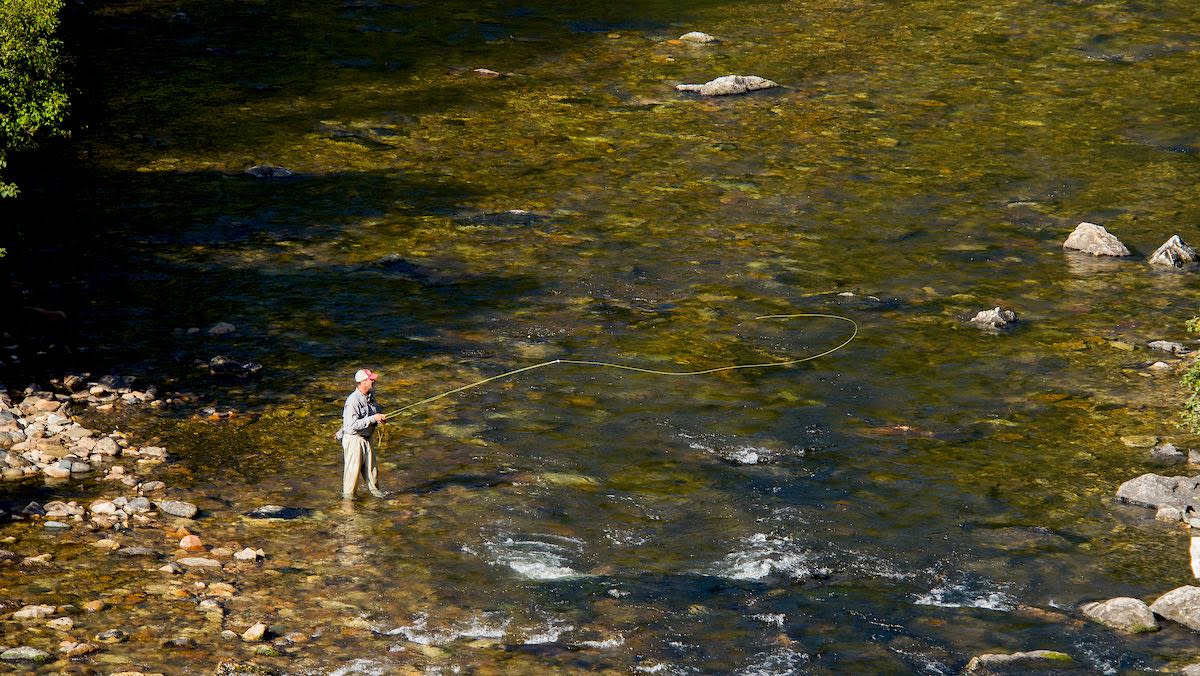
The aristocratic culture of trout fishing has put the fish on a pedestal. We tend to view them as this highly intelligent, finicky fish that swims around turning their noses up at flies and lures and quoting Izaak Walton to one another.
In turn, we anglers who pursue the trout feel that we have to be prepared for anything. I don’t know how many fly rods I actually own. Every time I think I have a rough count, I end up finding another rod tube in my closest or in the back of my truck. I also have an entire closet full of spinning rods and tackle boxes filled with every fly, hook, lure, and bait that has ever caught my eye in the sporting goods isle. And, while having all this equipment is awesome and covers me in whatever trouty situation I face, I know that I don’t really need most of it to catch trout. That’s because trout aren’t as smart as we make them out to be.
Simplify
When you really look at a trout, you see that they have a big mouth capable of eating almost anything, plus a small brain. That brain that spends most of its energy thinking about where the next meal is coming from. Trout are a species of opportunity. They’ll feed on one thing in the morning and then start eating something different in the afternoon. This leads most anglers to rifle frantically through their tackle trying to find the right presentation.
Instead, I always try to remember what it was like trout fishing as a kid. Back in those days I did most of my fishing with just a hook, a worm, and a couple spinners. When I got into fly fishing, I had one rod and one box of flies. I was rarely able to “match the hatch,” yet I still caught a ton of trout. My limited options forced me to fish well. I’d read the water, looking for pools and breaks in the current, and I’d look for trout. I’d see how they reacted to whatever I was offering, and I’d adjust accordingly. It made me a better trout fisherman.
Presentation, not Pattern
Being a good trout angler doesn’t mean having everything for every situation. It means being able to adapt what you have to the current situation. We’ve all seen those anglers at the boat ramp, loading their boat with tackle boxes like it’s a baggage cart at the airport. We’ve all seen—and heard—those fly fishermen jingling like a reindeer on Christmas Eve as they walk down the riverbank with every tool from a nail-knot tyer, to hemostats, to toe-nail clippers dangling from their zinger-dotted fishing vests. It’s almost all unnecessary.
Instead, try going down to the river with just one rod. If you’re spin fishing, bring just a few select lures like some small Rapalas, a couple Panther Martins, and maybe a bare hook or two for any bait you find along the way. If you’re fly fishing, bring one small box of flies. Fill it with a couple different sizes of Pheasant Tail and Prince Nymphs, which are good contrasting patterns. Put in a couple Parachute Adam’s dry flies, a couple different colored Stimulators, and maybe a Wooly Bugger and a Clouser Minnow or two. Then just clip a pair of hemostats with scissors to your shirt and throw a spool of 3X tippet in your pocket. That gear will get you through 75% of the trout situations you may face.
Adjust and Adapt
When you start fishing, instead of constantly switching out your lure or fly, try adjusting your strategy. If you’re spin fishing, change your retrieve speed and adjust your orientation. Fish faster water where the trout have less time to look at your lure and must just react. When you’re fly fishing, instead of constantly changing fly size or type, try fishing other parts of the water. Add more weight to your nymphs and drift a different depth. If the trout aren’t rising to your dry flies in the main current, start fishing them in the dead water on the edges of the current. Give the fly a twitch instead of dead drifting. A resting trout might capitalize on the opportunity. Look for trout and see how they react. Adjust, adapt, overcome, and learn from what works. It will help you better understand how trout behave, which will lead to catching more fish.
Many of us love trout fishing so much that we invest in the gear for decades and accumulate unreasonable amounts of it. And when we have so much equipment at home, going trout fishing with just a rod and a few flies or lures stuck in your hat feels weird.
Honestly, going fishing with minimal gear kind of like walking around your living room naked. You do it hesitantly at first, afraid of somehow being caught and embarrassed. But, after a while, that modesty and fear of being judged fade away and you just feel free.
Feature image via Tosh Brown.





